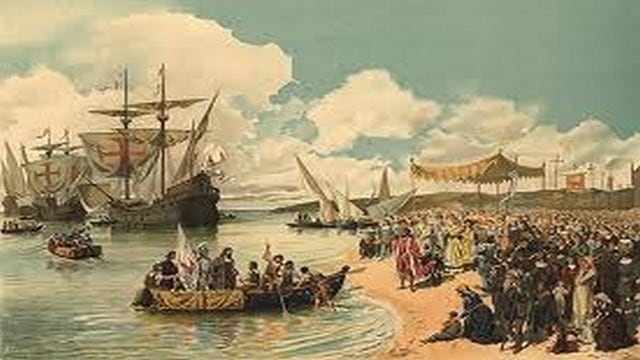Largest Empires In History
 Add image to section
Add image to section
British Empire

The British empire was the largest empire by landmass that covered 33.7 million km2. Because of its massive size, it is said that the sun never sets on the British Empire because it spans across the globe ensuring the the sun was always shining on at least on every territory abroad. Everywhere which belongs to the crown, its political, linguistic, and cultural legacy stretches far and wide.
 Add image to section
Add image to section
Mongol Empire

The Mongol World Empire was established in modern day Mongolia which was established by Genhis Khan and was declared as the ruler of all Mongols.It’s emergence from the unification of the Mongol and Turkic tribes in modern day Mongolia. Because of the advancements, new technologies and various commodities were disseminated.
 Add image to section
Add image to section
Russian Empire
 Add image to section
Add image to section
Spanish Empire
 Add image to section
Add image to section
Umayyad Caliphate

The second of the four Islamic caliphates, it covered more than 5 million square miles making it the largest Arab-Muslim state in history. It employed the best administration system the world has yet to be seen and the fifth largest contiguous empire to exist.This period is also known as the Arab Golden Age. Originally from the city of Mecca, Damascus became its capital.
 Add image to section
Add image to section
Qing Dynasty

The Jurchen Aisin Gioro Clan in Northeastern China founded the Qing dynasty which was the last imperial dynasty in Chinese history. Even if it was a Manchu led dynasty, their culture became highly integrated into the Chinese culture. Typical government policies were followed alongside the ones brought in by the founder of the dynasty. Due to rebellions, natural catastrophes and getting defeated in wars against the western kingdoms
 Add image to section
Add image to section
Yuan Dynasty

Kublai Khan, the famous ruler in the 11th century officially proclaimed the dynasty. Considered the successor of both the Mongol Empire and an imperial dynasty, the period bore the Mandate of Heaven. Also called the Empire of the Great Khan , Kublai Khan claimed the title of Great Khan as someone higher than the other successor khanates.
 Add image to section
Add image to section
French Colonial Empire

Extending over 12 million square kilometers, these set of territories were under French rule from the 17th century to the late 1960′s. During the 19th to 20th century, it was the second largest in the world next to the British Empire. France’s conquest reached Africa and Southeast Asia with the idea that the higher races have the right to civilize the lower races.
 Add image to section
Add image to section
Abbasid Caliphate

The Abbasid Caliphate was the successor of the Umayyad caliphate which was founded in Kufa in 750 CE and later established Baghdad as their capital in 762.Also known as the Islamic Golden Age, this period valued the intellectual capacity of their citizens and aims to maximize it to its full potential. This caliphate then became the intellectual center for the sciences, philosophy and education.
 Add image to section
Add image to section
Portuguese Empire

Also known as the Portuguese Overseas Empire, was the first global empire in history which spanned almost six centuries from 1415 when Ceuta was captured, until Macau’s handover in 1999 to the grant of sovereignty to East Timor in 2002. All the territories that was once part of this overseas empire now is a part of 53 different sovereign states. Advancements in navigation, cartography and maritime technology allowed sailors to rediscover routes and places in surrounding territories and as extensive as circumnavigating the globe.
 Add image to section
Add image to section
Rashidun Caliphate

In a span of 24 years of conquest, the first four caliphs in Islam’s history stretched far and wide into North Africa, the Middle East, Transoxiana, the Caucasus, the entire Sassanid Persian Empire plus the islands of Cyprus, Rhodes, the Greater Khorasan, the empires down to the lower Indus river and onto the Western Frontiers to the Atlantic Ocean. This developed Islamic empire had implemented systematic economic policies and strategies like the Bait-ul-Maal or public treasury.
 Add image to section
Add image to section
Empire of Brazil

The Empire of Brazil became the seat of the Portuguese Colonial Empire but was made independent by the son of the king who made it as such. Thus, Pedro I, the son of King Dom João VI, became the first emperor of Brazil. The restriction of slavery was one of the highlights of this era until it was finally abolished in 1888. Although Pedro I’s son Pedro II was able to sustain the peace and economic prosperity, he was not able to sustain the kingdom per se. After a 58 year reign, the empire was not able to hold up on the coup d’etat and eventually fell due to the lack of support.
 Add image to section
Add image to section
Achaemenid Empire

In the 6th Century, Cyrus the Great founded the First Persian Empire or the Achaemenid Empire. Named after King Achaemenes, it spanned from the Indus Valley in the east, onto the northeastern border of Greece. It’s line of monarchs aimed to unify the tribes and nationalities through the complex of roads that they constructed. If ranked by population percentage, this empire is the largest with 44% of the world’s population belonging to it.
 Add image to section
Add image to section
Japanese Empire

As a member of the Axis alliance, who could forget how powerful the Japanese empire was in World War II? As the largest maritime empire in history, it spanned more than 7 million square kilometers and gained such notoriety that it took atomic bombings in Hiroshima and Nagasaki plus plenty of defeats to surrender and reconstruct to what is now known as Nippon-koku or State of Japan.
 Add image to section
Add image to section
Sassanid Empire

During it’s Late Antiquity period, the Sassanid Empire is known to have been one of Persia’s most important and influential historical eras. As it stretched farther out to the western parts of Europe, Africa, China and India, it then played a significant roll in the development of European and Asian medieval culture.
 Add image to section
Add image to section
Ming Dynasty

The Empire of the Great Ming is the second to last Imperial era in Chinese history. It is popularly described as “one of the greatest eras of orderly government and social stability in human history”. It is also the last dynasty that was ruled by the ethnic Han Chinese. Due to natural and man-made catastrophes, the Ming fell and paved the way for the last imperial dynasty, the Qing.
 Add image to section
Add image to section
Roman Empire

Many fundamental components of the modern world were influenced by the Roman Empire which should come as no surprise considering that it was around for nearly 1,500 years. It had a profound and lasting influence on the development of language, religion, architecture, philosophy, law, and forms of government in the territory it governed, particularly Europe, and by means of European expansionism, the rest of the modern world.
 Add image to section
Add image to section
Han Dynasty
 Add image to section
Add image to section
Nazi Germany

Adolf Hitler is perhaps one of the most infamous figures of the twentieth century. As he controlled the government of the Third Reich, he also transformed it from a republic to a dictatorship employing the process of Gleichschaltung. Although the Nazi government survived quite well and was even flourishing during the Great Depression when the world was in dire straits, it’s infamy arose to even more incredible heights due to their advocacy on racism, specifically antisemitism, causing the ruthless bloodshed that eventually came to be known as the Holocaust.
 Add image to section
Add image to section
Göktürk Khaganate

In 552, the First Turkish or Türk Empire was founded by Bumin Qaghan and his sons. This nomadic confederation had extensive interaction with other kingdoms or dynasties from the northern part of China. Fifty years after the collapse of the First Turkish Empire, the Second Turk Empire was established and controlled the eastern part of the previous kingdom. The Orkhon inscriptions that have been preserved and still exist until today were produced during that time.
Load more items (5 more in this list)
Conquering nations and relentlessly expanding their territories has always been a favorite past time of those in power. Whether it was the Romans, Greeks, or Ottomans, it seems that amassing resources, nations, and the pursuit of a powerful legacy played a huge role in the rise and fall of their empires. Although today we no longer see borders shifting back and forth so rapidly, the art of imperialism is still alive and well. Here are the 25 largest empires in history.
Added to
19 votes
Favorite lists published in 2014
(80 lists)list by Nusch
Published 10 years, 5 months ago  1 comment
1 comment
 1 comment
1 commentPeople who voted for this also voted for
Tori Amos : My Top 10 Favorite Songs
Favorites of Naomi Watts
Most important philosophical concepts
Time Demanded To Complete Reading
Historic Sites of Ireland
Watched or Rewatched through the years
The Evolution of Isabelle Fuhrman
Modern Madcap - Harveytoons - Cartoon Shorts
perfectly timed photos
Licence Renewed (2004)
1990 : My Top 10 Favorite Songs
The Iridescent Sounds of 2019
Attractive Writers
British Comedy: Citizen James
British Comedy: Get Back
More lists from Milena
Fantastic Digital Paintings by Belgian Artist Jona
Comedy Wildlife Photography Awards 2016
I beautiful flowers photos?
It’s Hard To Believe That Humans Can Be This ....
Mind Blowing Digital Paintings and Illustrations..
Toy Dog Breeds
Mind Blowing Photo Manipulations and Retouching ..
 Login
Login



























